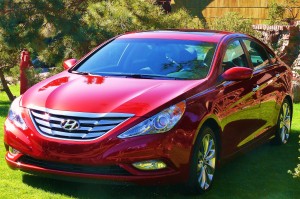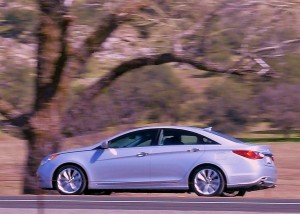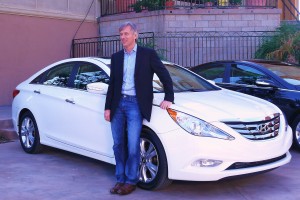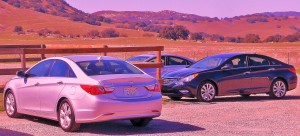2011 Sonata lifts Hyundai to midsize supremacy
SAN DIEGO, Calif. — The calendar said 2010 had a long way to go when Hyundai showed it was already soaring into 2011 when it introduced its all-new Sonata in late January, causing an unprecedented attraction for new customers to Hyundai showrooms all across the U.S.
The Sonata hit the streets in 2005, rising steadily to become a cost-effective alternative to the Honda Accord, Toyota Camry, Ford Fusion, Chevrolet Malibu, Mazda6, Nissan Altima, and whatever other nameplate you can crowd into that mainstream “midsize” form chart. With the Sonata as its primary weapon, Hyundai surprised the auto world for calendar 2009 by actually making a profit and gaining marketshare in a year when all those others suffered losses serious enough to resemble a series of mega-earthquakes that sent tremors through the industry.
Before you can say “Who are these guys?” Hyundai has unleashed the 2011 Sonata, being built in the new high-technology plant in Montgomery, Alabama. Think about it: A whole lot of good-ol’ Southerners, including rednecks, embracing a South Korean company, which is stabilizing the regional economy by building a car in a U.S. plant, using U.S. workers. Fascinating concept. But it’s only as good as the car that comes out the door, and the new Sonata is very good indeed.
In my opinion, the new Sonata is the best-looking of the whole batch of midsize cars. At a glance, it appears Hyundai kidnapped the Mercedes designer who drew up the superbly styled CLS “four-door coupe” sedan, with its sweeping, coupe-like silhouette. If the logo on the grille said Acura or Lexus, or Mercedes, it would cost twice as much. The Sonata’s slippery shape has a coefficient of drag of 0.28. Lower is more aerodynamic, anything under 0.35 is good, and 0.32 is excellent, so 0.28 is off the charts, even for a sports car.
Under that artfully-sloped body bolsters the prediction that the Sonata is an immediate favorite contender for 2011 Car of the Year. Pick whichever characteristic is most important — base price, loaded price, fuel economy, engine technology, transmission function, precise steering, sporty and agile handling, firm-but-not-harsh suspension, supportive seats, interior amenities, head and legroom, trunk space — the new Sonata has the whole package.
Competitors all start in the mid-$20,000 range, and soar to $35,000 at the drop of a nav system. By comparison, the Hyundai Sonata has three models: The GLS starts at $19,295 but is pretty well equipped, the sportier SE starts at $22,595, and the top-level, leather-clad-seat Limited starts at $25,295. True, you can add all sorts of neat features and drive those prices up, but a fully loaded Limited, with everything, including navigation system, would still be under $28,000.
The new Sonata comes only with a 4-cylinder engine. No V6 option. John Krafcik, the President and CEO of Hyundai America, explained that 88 percent of Sonata buyers choose the 4. “If 12 percent of the buyers buy V6es, then the other 88 percent have to have the heft of a platform built to house the V6,” said Krafcik. In contrast, designing the platform around only the 4 means the new Sonata could be tighter, leaner, stronger, and safer, from a construction standpoint. Even a brief drive in the new Sonata is convincing about the unified feel and the potency of the engine’s advanced design.
The Theta II GDI engine has all the latest high-tech tricks. Not only does it have dual overhead camshafts and four valves per cylinder, but it adds dual variable valve-timing, and gas direct-injection, which sends those dished pistons churning with impressive results. All those top competitors have 4-cylinder engines measuring either 2.4 or 2.5 liters, and all are DOHC designs. But direct injection lifts the Sonata to 198 horsepower and 184 foot-pounds of torque. By comparison, the Accord’s 2.4 has 177 horsepower/161 foot-pounds of torque; the Altima’s 2.5 has 175/180; the Fusion (and Mazda6) 2.5 has 175/172; the Camry’s 2.5 has 169/167; and the Malibu’s 2.4 has 169/160.
For those questioning Hyundai’s technology, Exhibit A is a horsepower edge that ranges from 21 horses over the runner-up Accord to 29 over the Camry and Malibu, and Exhibit B is the torque edge ranging from 4 more foot-pounds than the runner-up Altima to 24 better than the Malibu. For good measure, the SE model of the Sonata goes slightly upward, to 198 horses and 184 foot-pounds.
If you’re looking for Exhibit C, the Sonata has EPA fuel economy figures of 22 city and 35 miles per gallon highway for the automatic, and 24/ 35 with the manual. All the 4-cylinder models in the midsize class have good EPA numbers, ranging from a low of 22 in city driving for all but the Altima’s 23, up to a high of 35 — by the Sonata — on the highway cycle. Other highway EPAs show the Accord and Fusion at 31 with automatics, the Camry and Malibu 33 each, and the Fusion 34 with the stick.
In real-world driving, however, there is reason to believe the Sonata will expand its edge substantially, leading to Exhibit D. Krafcik, a sharp-witted, clever, and candid fellow who has bold ideas and carries them out, discussed the vagaries of EPA estimates with me a couple years ago. I mentioned how some companies make engines with good fuel economy, others have trouble approaching their EPA estimates, and still others hide behind impossible-to-achieve EPA numbers and refuse to even discuss “real world” gas mileage, which might be significantly less. Krafcik said: “Now that we’ve gotten our EPA fuel economy numbers up where we want them, our next objective is to make our real-world gas mileage the best, too.”
After his minions set up the mountain roadways near San Diego for the media test drives, Krafcik drove a new Sonata over the route and got remarkably good gas mileage, prompting him to challenge the media members to spend part of the drive enjoying the curvy mountain roads and the car’s performance, up to and past the Julian Pie Shop, and then to strive to see who could get the best fuel economy on the return route, from the South Coast Winery to Torrey Pines hotel.
Being a gas-mileage zealot, I set the on-board computer on the curvy part, as well, and got 38.3 miles per gallon. Very impressive. On the return, much of the 60.3 miles was freeway, and I was driving with a Hyundai engineer who also was a hockey fan. We got engrossed in great conversation, about Herb Brooks, and a book I’ve written about his coaching career, and comparing the Olympics then and now. All of a sudden, as we approached Exit 27, he said: “Oops! We were supposed to turn on Exit 19.”
Not a problem. We cut across the countryside and got there, in plenty of time. I enjoy mileage tests, but not the “hyper-mileage” tricks of extremely slow and bothersome speeds. I attempted to draft behind a large, square-back semi part of the way, but I did maintain the speed limits rather than driving super-slow just for economy. I averaged 46.8 miles per gallon, and I was amazed. When we heard the winning tandem recorded 52.8 miles per gallon, and second best was 49.0, we accused them of going 40 miles per hour on the shoulder.
Flashing back to EPA estimates, Hyundai now averages 30.1 miles per gallon for its entire fleet. Honda is second best at 29.7, Volkswagen 29.6, and Toyota 29.4. But Hyundai is the only manufacturer to have a corporate average over 30 miles per gallon. And when you consider that the Sonata so easily topped its 35-mpg EPA highway estimate, and so readily could attain 40-plus, you realize technology has allowed Krafcik’s vow to blossom.
In overall length, the Sonata is 189.8 inches, while the Camry is 189.2, the Fusion 190.6, Altima 190.7, Malibu 191.8, the Mazda6 193.7, and the Accord 194.1. Interestingly, though, the Sonata has a total interior volume of 120.2 cubic feet, while the Accord has 120.0; those are the only two in the class that meet large-car interior limits, while the rest are properly midsize, as the Fusion lists 116.8, the Camry 116.4, the Altima 116.0, and the Malibu 112.8. The Sonata’s mix shows passenger volume of 103.8, where only the Accord’s 106.0 tops it, and a cargo volume of 16.4 cubic feet, where only the Fusion’s 16.5 beats it. The Accord, with top passenger volume, has the least cargo volume in the class at 14.0.
The Sonata weighs only 3,161 pounds with a 6-speed manual — yes, a stick-shift! — while with a 6-speed automatic, the Sonata weighs a still-svelte 3,199 pounds. The Altima, at 3,180 pounds, is the only one lighter, while, for example, the Accord is 3,269, the Camry 3,307, the Fusion 3,342, and the Malibu 3,415.
Combining more power — from technical advances, not enlarged displacement — with lighter weight gives the Sonata a clearcut edge in acceleration. But its handling is also impressive. With strut front and multi-link rear suspension, the SE model has 23-percent firmer front and 8 percent firmer rear shocks, with a 13-percent larger rear stabilizer bar. That helps adroit handling, and the steering and design give the Sonata a 35.8-foot turning radius. Comparatively, the Camry and Altima need 36.1 feet, the Fusion 37.5, the Accord 37.7, and the Malibu 40.4 feet. Which do you like for a U-turn?
It is neat that the Sonata can be obtained with a 6-speed stick, but its new Shiftronic automatic is also a 6-speed, and Exhibit D is that the unit is Hyundai’s own transmission, making Hyundai one of only three automakers to have invented their own proprietary 6-speed automatics. A manual shift gate on the shift lever is augmented by steering wheel paddles on the SE models for manual control of the automatic. It took four years of development, and the 6-speed automatic is 26.5 pounds lighter than the 5-speed unit it replaces, and it also is shorter and has 62 fewer moving parts.
Hyundai — which only started assembling other company’s cars in the late 1960s and didn’t build its own vehicles until the 1990s — has made up a couple of decades of ground on long-term rivals in the past couple of years. The 2.4 engine lifts the company’s engineers to a higher plane, and they followed up with the superb DOHC V8 that propelled the large Genesis to 2009 Car of the Year honors. They next refined their V6, then came back and improved the 2.4, adding a high-pressure direct injection system. Meanwhile, at the New York Auto Show in the spring, Hyundai unveiled two more models to the still-new 2011 Sonata, one a 2.0-liter 4-cylinder turbo sporty model, the other a hybrid built entirely with Hyundai technology.
Back to Krafcik, who might be classified as a slice of 8-grain bread with lots of nuts and seeds, in a world of white-bread auto executives who seem to be alternatingly defending their losses and creating illusions about hopes for the future. Krafcik inspired my bread analogy with a comment at the introduction of the Sonata.
“Our success in 2009 was the culmination of a lot of hard work,” Krafcik said. “When the economy is hurting, people do more research and put more effort in deciding on their choices. That helps us. We brought out the 2011 Sonata with some Super Bowl ads, and they worked well, especially for a brand like ours, where our image hasn’t caught up with our capabilities. The Sonata is in the ‘white bread’ segment, and we have three objectives: We want to be a rational choice, we want to lead the way in being environmentally friendly, and we want to make an emotional connection.”
With such features as side-impact airbags and stability control standard, and a transferable powertrain warranty of 10 years or 100,000 miles, Hyundai has taken care of rational consideration. As for depreciation and residual value, Hyundai now is better than Toyota or Ford. For residual value, the Accord retains 54 percent of its value after three years, with the Sonata second at 53 percent, followed by the Altima 51 percent, Camry and Fusion at 49 percent, and Malibu at 46 percent. And that is not considering the new 2011 Sonata, with all its improvements.
Two or three years ago, I was reluctant to recommend a Korean car to anyone who asked my advice. Improved though they were, they were still in formative form against the slick Japanese, the potent Germans, and even the U.S., bent as some manufacturers seemed to be on self-destruction from varying doses of arrogance and complacency. The Fusion won 2010 Car of the Year in hybrid form, the Mazda6 has risen to sporty styling heights, the Malibu has improved in current form, and the Altima, Accord and Camry all are larger and their usual solid selves. But right now, I would insist that any serious buyer comparison shop the 2011 Hyundai Sonata.
Comments
Tell me what you're thinking...
and oh, if you want a pic to show with your comment, go get a gravatar!






 John Gilbert is a lifetime Minnesotan and career journalist, specializing in cars and sports during and since spending 30 years at the Minneapolis Tribune, now the Star Tribune. More recently, he has continued translating the high-tech world of autos and sharing his passionate insights as a freelance writer/photographer/broadcaster. A member of the prestigious North American Car and Truck of the Year jury since 1993. John can be heard Monday-Friday from 9-11am on 610 KDAL(www.kdal610.com) on the "John Gilbert Show," and writes a column in the Duluth Reader.
John Gilbert is a lifetime Minnesotan and career journalist, specializing in cars and sports during and since spending 30 years at the Minneapolis Tribune, now the Star Tribune. More recently, he has continued translating the high-tech world of autos and sharing his passionate insights as a freelance writer/photographer/broadcaster. A member of the prestigious North American Car and Truck of the Year jury since 1993. John can be heard Monday-Friday from 9-11am on 610 KDAL(www.kdal610.com) on the "John Gilbert Show," and writes a column in the Duluth Reader.